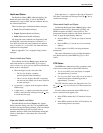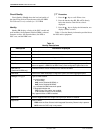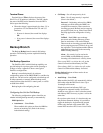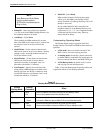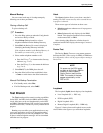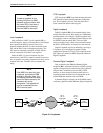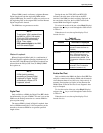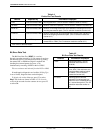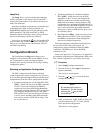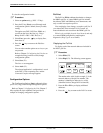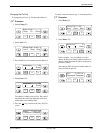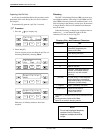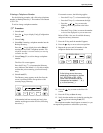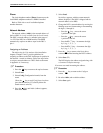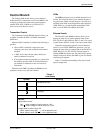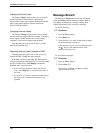
Operating the DSU
4-133615-A2-GB20-20 December 1996
Lamp Test
The Lamp T
est is a local test of the status indicators
(LEDs) and liquid crystal display (LCD) on the DSU’s
control panel (both models). Any indicator that does not
flash is not functional.
Note that if all LEDs are functioning, all the indicators
on the Model 3615 DCP are flashing steadily
. In a
COMSPHERE 3000 Series Carrier, the indicators on the
SDCP remain ON. The LCD on the DCP or SDCP
alternately flashes solid blocks, moving from position to
position on the display until the test is aborted.
Pr
essing any key
except
the key will stop the LCD
portion of the Lamp Test and return you to the DSU Test
menu so you can abort the test. Once aborted, the LCD
and LEDs stop flashing.
Configuration Branch
The Configuration (Confg) branch allows you to
configure or customize the DSU and its DBM to fit your
site’
s requirements, to enter and change telephone
numbers, and to specify the mode for viewing or editing
configuration options.
Selecting an Application Configuration
The DSU is shipped from the factory with three
common applications already configured. All you have to
do is select the appropriate application and load the preset
configuration into the unit. These configurations include:
• Synchronous Backup for a Control DualFlow DSU
(SyBC) – Sends user data over the DDS connection
via the V
.35 port, and configures the DBM for
synchronous user
-data transfer during Bandwidth
on Demand or backup situations. This configuration
also configures the DualFlow DSU to dial when
DTR on the EIA-232 port transitions from inactive
to active, and to disconnect when DTR transitions
from active to inactive (DTRCallCon: Orig). Used
for a control device.
• Synchronous Backup for a Tributary DualFlow
DSU (SyBT) – Sends user data over the DDS
connection via the V
.35 port, and configures the
DBM for synchronous user
-data transfer during
Bandwidth on Demand or backup situations. This
configuration also configures the DualFlow DSU to
answer calls only when DTR on the EIA-232 port is
active, and to disconnect when DTR transitions
from active to inactive (DTRCallCon: Ansr). Used
for a tributary device.
•
Dial Diagnostics (
DiDg) – Sends user data over the
DDS connection via the V.35 port, and configures
the DBM for asynchronous router-management
data and for disruptive diagnostics.
Select the appropriate configuration based upon how
the unit will be used within your network. All
configurations support simultaneous DDS and DBM
connections. The dif
ference is in how the DBM
connection is used.
Refer to the Application Configurations in Appendix E
for examples using these three configurations. Refer to the
DSU’
s menu in Appendix A as you follow these steps.
. Procedure
1.
Select
Confg (Configuration branch).
2.
Press the F1 key to select
Opts (Configuration
Options subbranch).
The
Load fr
om
screen appears.
3.
Press the
or key to scroll the desired
configuration into view.
NOTE
By referencing the menu in
Appendix A, you will see that
pressing the key is often
more efficient.
4. Make your selection:
SyBC, SyBT
, or DiDg, and
press the function key (F1, F2, or F3) directly
below the desired configuration.
The Edit/Save
screen appears.



